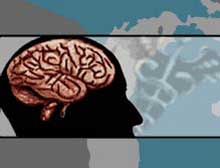
|
(CNN) -- Whether it's a mouse versus a cat, or a human versus an oncoming car, a well-placed sense of fear is critical for survival.
But there's also danger when that fear is so overwhelming that it keeps an animal or human from functioning.
Researchers say they have now pinpointed the part of the brain in laboratory rats that functions to calm fears when it is stimulated. Scientists say further studies may help in treating humans with anxiety disorders, such as post-traumatic stress disorder.
"The reduction of fear is an active, not a passive process," said Gregory Quirk, associate professor of physiology at Ponce School of Medicine in Puerto Rico.
Animals lose their fears by learning new memories, not erasing the old ones, said Quirk, whose work is published in this week's edition of the British journal Nature.
The proper balance between learning new memories and erasing old ones is important. The prefrontal cortex, in the front of the brain, appears to be where the brain learns not to be afraid.
Findings mesh with treatments
These findings seem to weave in well with some types of treatments now used on patients with post-traumatic stress disorder, said Robert Hayes, professor emeritus of psychology and counseling at Ball State University in Muncie, Indiana.
Therapies known as EMDR -- eye movement desensitization and reprocessing -- and cognitive behavioral therapy are used to get the patient desensitized to the event that caused the trauma.
"All of these things have the patient deal again and again with the trauma in a safe way, so the original trauma doesn't have the power to tap into those fears," said Hayes. He said Quirk "may be on to something" in his study, but there's often a long road from research with rats to similar results with humans.
Some therapists already are testing a technique that uses a magnet to stimulate the safety center of the brain in patients with anxiety disorders. It is hoped that technique, called transcranial magnetic stimulation, will help some patients control their anxiety attacks.
How the research worked
Here's how researchers came to that conclusion:
The scientists conditioned laboratory rats to associate a certain tone with an electric shock to the foot. After a few such tests, the rats heard the same tone but did not get a shock. Many of the rats still froze when they heard the tone, even though they weren't getting a shock.
That reaction is the same type of association that Ivan Pavlov became famous for when he conditioned dogs to associate the ringing of a bell with the smell of meat, causing them to salivate when they heard the bell alone.
On a second day of tests, the tone was again played without the shock. What Quirk found was that the animals with the most activity in their prefrontal cortex were the least likely to freeze, or show fear, when they heard the tone. What this shows, Quirk said, is that a part of the brain is saying: Calm down, you don't always have to get stressed when you hear that tone.
Scientists call the process of inhibiting fear "extinction."
Quirk and colleague Mohammed Milad measured the electrical activity of neurons in the rats' brains through implanted electrodes. They found that increased activity of certain neurons strengthened the safety signal by inhibiting another part of the brain -- the amygdala -- that remembers fear.
"Basically what we did was eavesdrop on the conversation the cells were having," Quirk said.
Rats that showed the least amount of fear were those whose cells most robustly communicated the safety signal. That "all clear" signal helped the rats maintain their energy and focus, and not waste energy freezing unnecessarily.
Quirk compared the freezing response in the rats to the sweating or breathing difficulties some humans show when they have panic attacks. Such attacks often take place even when there is no real threat or danger to the person.
Human responses
While no similar tests have been conducted on humans, Quirk said it may be that people with anxiety disorders also have less activity in the prefrontal cortex, or "safety memory" in their brain. In that case, the amygdala may be stronger than the prefrontal cortex, making fear memories overpower safety memories.
The amygdala -- which makes cats run from dogs, and humans stay away from a corner where they were once mugged -- "may be the reason that when two combat veterans are walking down the street and hear a car backfire, one keeps walking and the other sweats and has a panic attack," Quirk said.